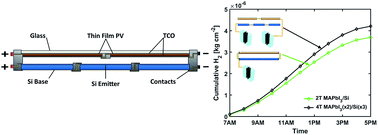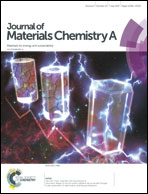Simulations of non-monolithic tandem solar cell configurations for electrolytic fuel generation†
Abstract
The efficient conversion of solar energy to fuels through electrochemical processes requires optimizing the photovoltage and current for an ideal coupling with the electrolysis reaction. A modular architecture for tandem photovoltaics is explored and modeled as a strategy to drive an arbitrary electrolysis reaction from sunlight to produce the maximum fuel product in a day. Non-monolithic tandem solar cells based on Si and organometal halide perovskites are simulated in two-terminal and four-terminal arrangements and coupled with experimental data on water-splitting and CO2 reduction to predict the performance of an integrated solar fuels system. An appropriately designed four-terminal system is modeled to match or exceed the output of a two-terminal system. The four-terminal configuration leads to a 15.8% increase in daily H2 production with a 1.5 eV/1.12 eV system, and a 5.3% increase with a more ideal 1.74 eV/1.12 eV combination. The four-terminal system is also simulated to match the production of formic acid and increase the production of ethylene by 20.4% in a Cu-catalyzed CO2 reduction process compared to a two-terminal tandem arrangement. The effects of series resistance in non-monolithic tandem devices are modeled as well, showing a much greater tolerance to cell width in the four-terminal systems.



 Please wait while we load your content...
Please wait while we load your content...